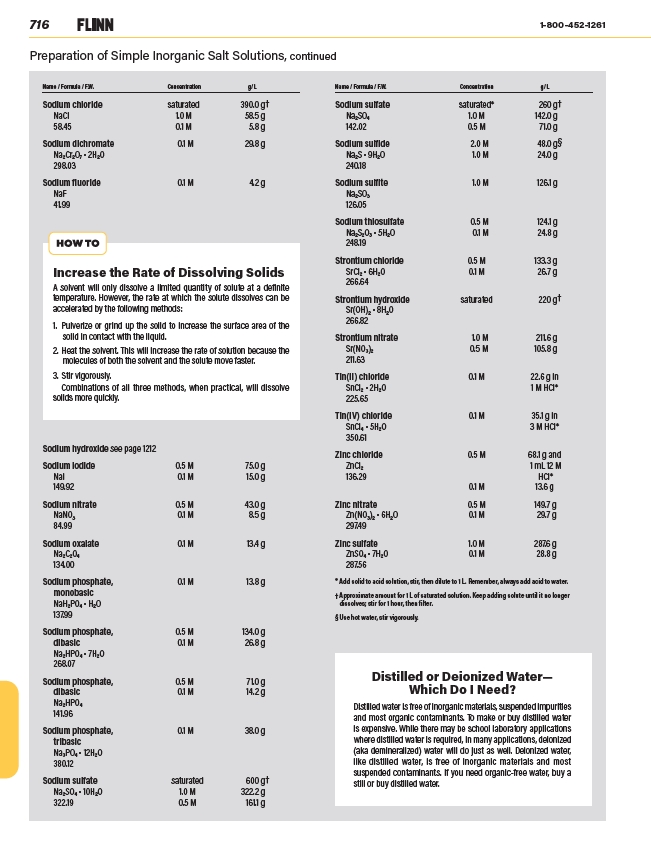
716 1-800-452-1261
Preparation of Simple Inorganic Salt Solutions, continued
Name / Formula / F.W. Concentration g/L
Sodium chloride saturated 390.0 g†
NaCl 1.0 M 58.5 g
58.45 0.1 M 5.8 g
Sodium dichromate 0.1 M 29.8 g
Na2Cr2O7 • 2H2O
298.03
Sodium fluoride 0.1 M 4.2 g
NaF
41.99
Sodium hydroxide see page 1212
Sodium iodide 0.5 M 75.0 g
NaI 0.1 M 15.0 g
149.92
Sodium nitrate 0.5 M 43.0 g
NaNO3 0.1 M 8.5 g
84.99
Sodium oxalate 0.1 M 13.4 g
Na2C2O4
134.00
Sodium phosphate, 0.1 M 13.8 g
monobasic
NaH2PO4 • H2O
137.99
Sodium phosphate, 0.5 M 134.0 g
dibasic 0.1 M 26.8 g
Na2HPO4 • 7H2O
268.07
Sodium phosphate, 0.5 M 71.0 g
dibasic 0.1 M 14.2 g
Na2HPO4
141.96
Sodium phosphate, 0.1 M 38.0 g
tribasic
Na3PO4 • 12H2O
380.12
Sodium sulfate saturated 600 g†
Na2SO4 • 10H2O 1.0 M 322.2 g
322.19 0.5 M 161.1 g
Name / Formula / F.W. Concentration g/L
Sodium sulfate saturated* 260 g†
Na2SO4 1.0 M 142.0 g
142.02 0.5 M 71.0 g
Sodium sulfide 2.0 M 48.0 g§
Na2S • 9H2O 1.0 M 24.0 g
240.18
Sodium sulfite 1.0 M 126.1 g
Na2SO3
126.05
Sodium thiosulfate 0.5 M 124.1 g
Na2S2O3 • 5H2O 0.1 M 24.8 g
248.19
Strontium chloride 0.5 M 133.3 g
SrCl2 • 6H2O 0.1 M 26.7 g
266.64
Strontium hydroxide saturated 220 g†
Sr(OH)2 • 8H2O
266.82
Strontium nitrate 1.0 M 211.6 g
Sr(NO3)2 0.5 M 105.8 g
211.63
Tin(II) chloride 0.1 M 22.6 g in
SnCl2 • 2H2O 1 M HCl*
225.65
Tin(IV) chloride 0.1 M 35.1 g in
SnCl4 • 5H2O 3 M HCl*
350.61
Zinc chloride 0.5 M 68.1 g and
ZnCl2 1 mL 12 M
136.29 HCl*
0.1 M 13.6 g
Zinc nitrate 0.5 M 149.7 g
Zn(NO3)2 • 6H2O 0.1 M 29.7 g
297.49
Zinc sulfate 1.0 M 287.6 g
ZnSO4 • 7H2O 0.1 M 28.8 g
287.56
* Add solid to acid solution, stir, then dilute to 1 L. Remember, always add acid to water.
† Approximate amount for 1 L of saturated solution. Keep adding solute until it no longer
dissolves; stir for 1 hour, then filter.
§ Use hot water, stir vigorously.
Distilled or Deionized Water—
Which Do I Need?
Distilled water is free of inorganic materials, suspended impurities
and most organic contaminants. To make or buy distilled water
is expensive. While there may be school laboratory applications
where distilled water is required, in many applications, deionized
(aka demineralized) water will do just as well. Deionized water,
like distilled water, is free of inorganic materials and most
suspended contaminants.
If you need organic-free water, buy a
still or buy distilled water.
Increase the Rate of Dissolving Solids
A solvent will only dissolve a limited quantity of solute at a definite
temperature. However, the rate at which the solute dissolves can be
accelerated by the following methods:
1. Pulverize or grind up the solid to increase the surface area of the
solid in contact with the liquid.
2. Heat the solvent. This will increase the rate of solution because the
molecules of both the solvent and the solute move faster.
3. Stir vigorously.
Combinations of all three methods, when practical, will dissolve
solids more quickly.